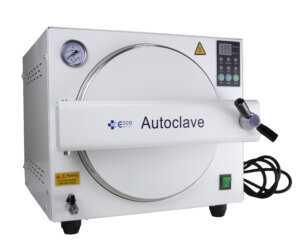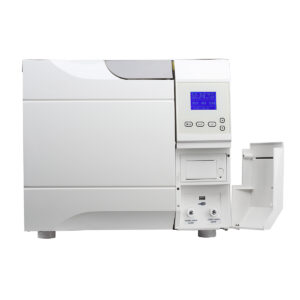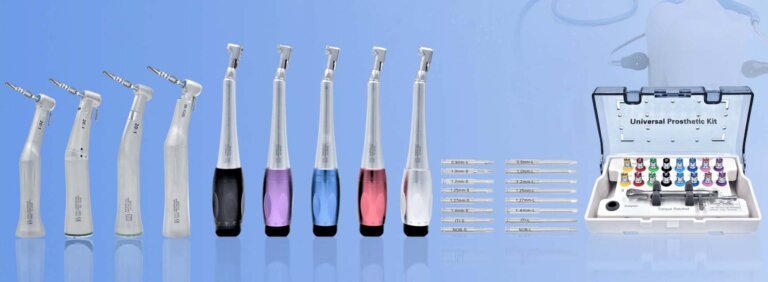How Do Steam Sterilization Cycles Work? | ESCO Dental Equipment
More worry free / Less effort / More competitive

Have you ever wondered how dental instruments are kept sterile? The key lies in the humble sterilization equipment in the clinic. As an industry insider for many years, I have witnessed how steam sterilization technology has become the patron saint of modern dental clinics.
🔹 How Do Steam Sterilization Cycles Work?
Steam sterilization remains one of the most trusted and effective ways to sterilize dental instruments. By using high heat and pressure, it thoroughly eliminates bacteria, viruses, and even the most resilient spores, helping dental clinics prevent cross-contamination and maintain a safe environment for patients.
🔸 What Is Steam Sterilization? Why Is It Important for Dental Equipment?
Steam sterilization, also known as autoclaving, is a process that uses high-temperature, pressurized steam to kill microorganisms on dental instruments and medical tools. It is the preferred sterilization method in dentistry because:
- It effectively destroys all forms of microbial life, including heat-resistant spores.
- It is safe for most dental instruments, ensuring durability and long-term usability.
- It provides rapid and consistent results, making it ideal for busy dental practices.
Dental clinics rely on sterilization to maintain strict infection control standards, ensuring patient safety and regulatory compliance.
🔸 The Core Principles of Steam Sterilization
Steam sterilization operates based on three critical parameters that determine its effectiveness:
Parameter | Description | Standard Range |
Temperature | Heat denatures microbial proteins, leading to cell destruction. | 121°C (250°F) – 134°C (273°F) |
Pressure | Keeps steam at high temperatures, ensuring even penetration. | 15-30 psi (pounds per square inch) |
Time | Ensures complete microbial destruction. | 4-30 minutes, depending on load type |
These parameters must be carefully controlled to achieve consistent and reliable sterilization results.
🔸 How High-Pressure Steam Kills Microorganisms
The sterilization process works through the penetration of high-temperature steam into dental instruments, effectively killing microorganisms by:
- Denaturing proteins – Heat disrupts the structural integrity of bacterial and viral proteins.
- Disrupting cellular metabolism – Microorganisms are unable to maintain vital functions.
- Destroying spores – The extreme heat and moisture eliminate even the most resistant microbial spores.
By understanding the fundamental principles of steam sterilization, dental professionals can ensure their sterilization process is both effective and compliant with industry standards. ESCO Dental Equipment offers high-quality sterilization solutions designed for dental clinics and distributors, ensuring safe and efficient instrument processing.
🔹 Key Stages of a Steam Sterilization Cycle
Steam sterilization follows a precise sequence of stages to ensure complete microbial elimination. Each phase plays a critical role in achieving optimal sterilization results while protecting dental instruments from contamination.
1️⃣ Preconditioning Stage (Air Removal Phase)
Before sterilization begins, it is essential to remove air from the autoclave chamber. This step ensures that steam can penetrate all surfaces of the instruments effectively.
There are two main methods for air removal:
Method | Description | Best for |
Gravity Displacement | Steam enters the chamber, pushing out the heavier air through a vent. | Simple instruments, solid tools. |
Pre-Vacuum | A vacuum pump actively removes air before steam enters, ensuring deeper penetration. | Hollow instruments, handpieces, wrapped items. |
✔ Why is air removal important?
- Air can act as an insulator, preventing steam from reaching all instrument surfaces.
- Improper air removal may lead to incomplete sterilization.
2️⃣ Heating & Sterilization Stage
Once the air has been removed, the chamber is filled with saturated steam at a controlled temperature and pressure. The instruments are exposed to these conditions for a set time to ensure complete microbial destruction.
Temperature | Pressure | Exposure Time |
121°C (250°F) | 15 psi | 15-30 minutes |
134°C (273°F) | 30 psi | 3-5 minutes |
✔ Key Factors for Effective Sterilization:
- Proper steam penetration – Instruments must be arranged to allow steam to reach all surfaces.
- Correct cycle selection – Different loads may require different sterilization times.
- Monitoring and validation – Regular testing ensures proper sterilization conditions are met.
3️⃣ Exhaust & Drying Stage
After sterilization, steam is released, and pressure in the chamber returns to normal. Proper drying is critical to prevent recontamination.
- Steam is vented out, and moisture evaporates.
- A drying cycle ensures that instruments are completely dry before removal.
- Incomplete drying can lead to microbial growth and instrument corrosion.
✔ Best Practices for Drying:
- Use an autoclave with a built-in drying function.
- Allow instruments to cool before handling.
- Store sterilized instruments in a dry, sterile environment.
At ESCO Dental Equipment, we deliver advanced steam sterilization solutions that combine efficiency, reliability, and full compliance with dental industry standards.
🔹 Types of Steam Sterilization Cycles
Different types of steam sterilization cycles are designed to accommodate various dental instruments and sterilization requirements. Selecting the appropriate cycle ensures maximum efficiency and complete sterilization.
1️⃣ Gravity Displacement Sterilization Cycle
✔ Best for: Simple, solid instruments such as forceps, scalpels, and metal trays.
✔ How it works:
- Steam is introduced at the top of the chamber.
- Heavier air is displaced downward and vented out.
- The chamber is filled with saturated steam, ensuring heat penetration.
Cycle Type | Temperature | Pressure | Sterilization Time |
Gravity Displacement | 121°C (250°F) | 15 psi | 15-30 min |
Gravity Displacement | 134°C (273°F) | 30 psi | 3-10 min |
✔ Advantages:
- Simple and cost-effective process.
- Works well for basic dental instruments.
⚠ Limitations:
- Less effective for hollow or porous instruments.
- Air pockets may remain, leading to incomplete sterilization.
2️⃣ Pre-Vacuum (High-Vacuum) Sterilization Cycle

✔ Best for: Hollow, porous, and wrapped instruments such as handpieces and tubing.
✔ How it works:
- A vacuum pump removes air from the chamber before steam is introduced.
- The absence of air ensures deep steam penetration, even in complex instruments.
- The sterilization process takes place under controlled pressure and temperature.
ycle Type | Temperature | Pressure | Sterilization Time |
Pre-Vacuum Cycle | 134°C (273°F) | 30 psi | 3-5 min |
✔ Advantages:
- More efficient sterilization for complex instruments.
- Ensures steam reaches all surfaces, reducing sterilization failures.
⚠ Limitations:
- Requires specialized autoclaves with vacuum capabilities.
- More expensive compared to gravity displacement cycles.
3️⃣ Pulsed Vacuum (Fractionated Vacuum) Sterilization Cycle

✔ Best for: High-demand sterilization needs in large dental clinics and hospitals.
✔ How it works:
- Multiple vacuum and steam pulses remove air completely.
- Steam is injected in short bursts, allowing deeper penetration.
- Designed for high-level sterilization with enhanced drying.
Cycle Type | Temperature | Pressure | Sterilization Time |
Pulsed Vacuum Cycle | 134°C (273°F) | 30 psi | 3-5 min |
✔ Advantages:
- Best sterilization efficiency, even for the most complex instruments.
- Shorter cycle time with better drying.
⚠ Limitations:
- Higher cost due to advanced technology.
- Mostly used in large-scale sterilization facilities.
By understanding the differences between these sterilization cycles, dental professionals can choose the most suitable method for their equipment. ESCO Dental Equipment offers advanced autoclaves featuring multiple sterilization cycles, ensuring superior infection control for dental clinics and distributors worldwide.
🔹 Factors Affecting the Effectiveness of Steam Sterilization
Achieving reliable and consistent sterilization results depends on multiple factors. Proper equipment, correct packaging, and adherence to operating procedures play a crucial role in ensuring complete microbial elimination.
1️⃣ Quality of Sterilization Equipment
The performance of an autoclave directly impacts sterilization effectiveness. Choosing high-quality sterilization equipment ensures safety, efficiency, and regulatory compliance.
✔ Key factors in a high-quality sterilizer:
- Precise temperature and pressure control – Inconsistent heat distribution can result in ineffective sterilization.
- Vacuum capability – Essential for removing air pockets in pre-vacuum and pulsed vacuum cycles.
- Durability and chamber material – Stainless steel chambers resist corrosion and maintain heat efficiency.
- Advanced monitoring systems – Digital tracking ensures sterilization parameters are met.
💡 Tip: Regular maintenance and calibration of autoclaves help maintain optimal performance and sterilization accuracy.
2️⃣ Proper Packaging of Instruments

How you package dental instruments before sterilization affects steam penetration and drying efficiency.
✔ Best practices for sterilization packaging:
- Use permeable sterilization pouches or wraps to allow steam to reach instruments.
- Avoid overloading trays, which can block steam circulation.
- Ensure instruments are properly cleaned and dried before packaging.
Packaging Method | Effectiveness | Best for |
Wrapped Instruments | ✅ Protects from contamination after sterilization. | Handpieces, surgical tools. |
Open Trays | ❌ Risk of recontamination post-sterilization. | Immediate-use instruments. |
Pouched Instruments | ✅ Ensures sterility for extended periods. | Small tools, burs, endodontic files. |
💡 Tip: Always use autoclave-compatible packaging and check for any damage before sterilization.
3️⃣ Adherence to Standard Operating Procedures (SOPs)
Following proper sterilization protocols helps prevent sterilization failures and ensures compliance with hygiene standards.
✔ Essential sterilization procedures:
- Correct loading of instruments – Allow sufficient space for steam to circulate.
- Use biological and chemical indicators – Verify that sterilization conditions have been met.
- Monitor cycle parameters – Ensure temperature, pressure, and time are within the required range.
⚠ Common mistakes leading to sterilization failure:
- Overloading the sterilizer can prevent steam from penetrating effectively.
- Using incorrect cycle settings for different instrument types.
- Skipping drying phases, leading to recontamination risks.
💡 Tip: Regular training for dental staff on sterilization procedures helps maintain consistent and effective instrument sterilization.
By understanding these key factors, dental professionals can optimize their sterilization process for maximum safety and efficiency. At ESCO Dental Equipment, we provide high-performance autoclaves and expert guidance to help dental clinics and distributors maintain the highest sterilization standards.
🔹 How to Choose the Right Steam Sterilization Equipment?
Selecting the appropriate steam sterilization equipment is crucial for ensuring that dental instruments are sterilized effectively and safely. The right equipment not only improves operational efficiency but also meets regulatory requirements.
1️⃣ Choose the Right Sterilization Cycle Based on Clinic Needs
Different dental practices require different sterilization solutions depending on the volume of instruments, type of treatments offered, and patient needs. Selecting the correct sterilization cycle mode ensures optimal results.
✔ Key considerations when choosing a cycle mode:
- For simple instruments (e.g., dental scalers, mirrors): The gravity displacement cycle is ideal.
- For hollow or porous instruments (e.g., handpieces, tubing): The pre-vacuum cycle ensures better steam penetration.
- For high-volume practices: The pulsed vacuum cycle offers faster and more efficient sterilization, reducing turnaround time.
💡 Tip: A multi-cycle autoclave with various sterilization options allows flexibility for a wide range of dental instruments.
2️⃣ Choose Equipment with International Certification
It is essential to choose sterilization equipment that meets international safety and quality standards. Certified equipment ensures that it complies with global health regulations and provides reliable sterilization results.
✔ Important certifications to look for:
- CE certification (European Union): Confirms that the equipment meets European safety standards.
- FDA approval (U.S.): Indicates that the equipment complies with U.S. health and safety regulations.
- ISO standards: Ensures that the autoclave is manufactured following international quality management systems.
💡 Tip: Always verify the certification of the autoclave before purchasing, especially when dealing with international distribution.
3️⃣ ESCO Dental Equipment Provides Reliable Sterilization Solutions
At ESCO Dental Equipment, we understand the importance of reliable and safe sterilization. We offer high-performance steam sterilizers tailored to meet the needs of dental clinics and distributors.

✔ Why choose ESCO?
- Our autoclaves feature advanced sterilization cycles, ensuring compatibility with different instrument types.
- We provide customized sterilization solutions based on your clinic’s workload and instrument needs.
- Our equipment is CE and FDA certified, guaranteeing quality and compliance with industry standards.
💡 Tip: ESCO Dental Equipment is your trusted partner for efficient, safe, and compliant sterilization solutions, ensuring the best care for your dental patients.
By considering your clinic’s specific needs and choosing certified, high-quality equipment, you can maintain optimal sterilization standards while enhancing operational efficiency. ESCO Dental Equipment is here to guide you in selecting the perfect steam sterilization solution for your practice.
🔹 Ensuring Effective Steam Sterilization in Your Dental Practice
In short, having a clear understanding of how steam sterilization cycles work is key to maintaining a safe, hygienic environment in any dental clinic. Using the right cycle, good equipment, and the right techniques can really help cut down the chances of cross-contamination and infection.
Successful steam sterilization involves more than just owning the right machine. The quality of your equipment, how you package instruments, and the attention you give to every step of the process all play a critical role.
At ESCO Dental Equipment, we know that reliable sterilization isn’t just about checking boxes – it’s about giving you the peace of mind to focus on what really matters: patients. That’s why we’ve carefully crafted a comprehensive range of sterilization solutions, designed not just to meet, but to simplify unique workflow challenges.
You can count on our CE- and FDA-certified equipment to keep your sterilization processes in line with the world’s highest standards.
Investing in ESCO Dental Equipment means investing in the future of your clinic’s sterilization capabilities, helping you provide the best care to your patients.
Related Dental Products
How Can We Help?
START YOUR DENTAL MEDICAL INSTRUMENT ONE-STOP PURCHASING JOURNEY







